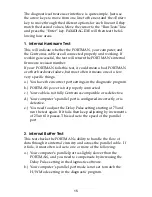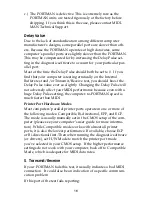
28
no longer readable and the PORTMAN 4x4/S sends a standard
MTC NAK (signal not acquired) message to the application to
indicate the tape has become idle.
About Frame Rates
All SMPTE time code and MTC carry the same primary informa-
tion, Hours:Minutes:Seconds:Frames. However, time code can be
written and read at different standard frame rates. These frame
rates designate the number of frames that each second is subdi-
vided into. Different video, film and audio standard frame rates
have been adopted. These various standards and typical applica-
tions are:
Frame Rate
Application
24 frames/second
Motion Pictures
25 frames/second
European Video - both B/W & Color
30 drop frame
U.S. Color Video
30 non-drop
U.S. B/W Video and U.S. Audio
Black and white video frame rates were originally derived from
the A/C line frequency of the indigenous country (e.g. 50 Hz in
Europe, 60 Hz in the U.S.). In the U.S. when color video was
introduced, part of the black and white frame information was
used to encode the color information. The result was that the
color frame rate ran at an effectively slower rate of 29.97 frames
per second. This slower rate can be approximated by running at
30 frames per second and skipping 108 frames per hour in the
numbering scheme. This method of “dropping” 108 frames/hour
to slow the effective frame rate was termed “drop frame.” Hence,
the standard frame rate used when doing U.S. color video is
called “30 drop frame”. When running at a true 30 frames per
second, this is known as “30” or sometimes “30 non-drop”.
As listed in the above table, in the U.S. and other “NTSC” coun-
tries, black and white (30 non-drop) and color (30 drop) video
have different frame rates. While in Europe and all “PAL” coun-
tries, black and white and color video have the same frame rate of
25 frames per second.






























